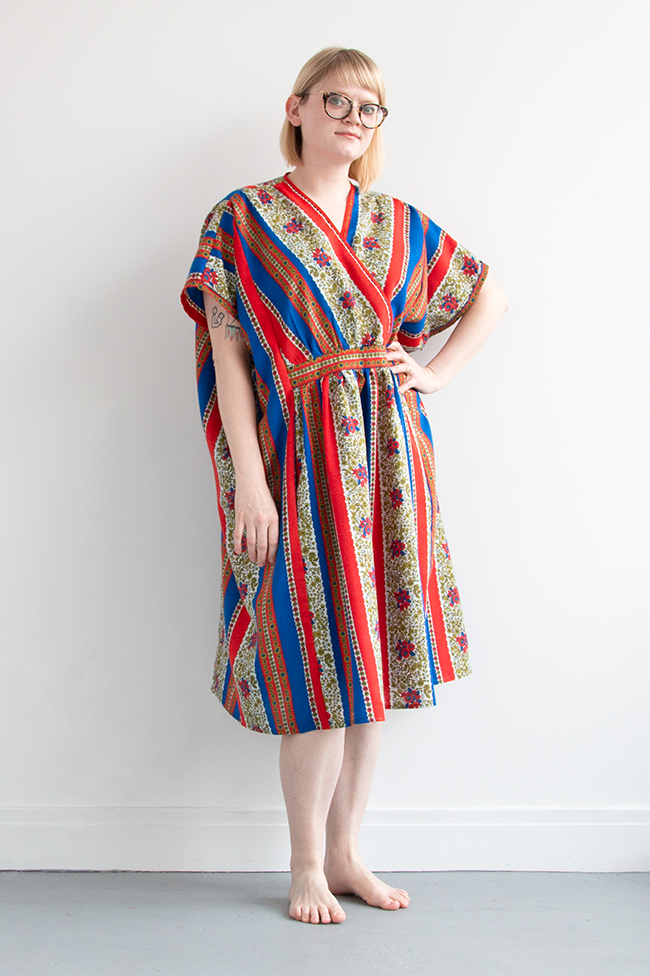
Last week, I teased a new series on this blog, in honor of Me Made May! But I should also mention that this series is also my way of starting to regularly share a little bit of sewing content, as requested in this year’s reader survey. Caught up? Good!
For today’s purposes, we are diving head first into one particularly unique addition to my handmade wardrobe: a caftan! As discussed in season 2,episode 9 of my podcast, Very Serious Crafts, this caftan has a bit of a story already. You see, my dear friend Anna is getting married this year, and this Memorial Day weekend marks her bachelorette party. The only requirement is to have a relaxed time and to wear a caftan at party HQ. While most normal people would simply buy a caftan (maybe even a vintage one if they’re real cool), I immediately speed-scrolled through my crafty mental rolodex and remembered a sewing pattern that had caught my eye. Enter the TLC Caftan from Decades of Style.
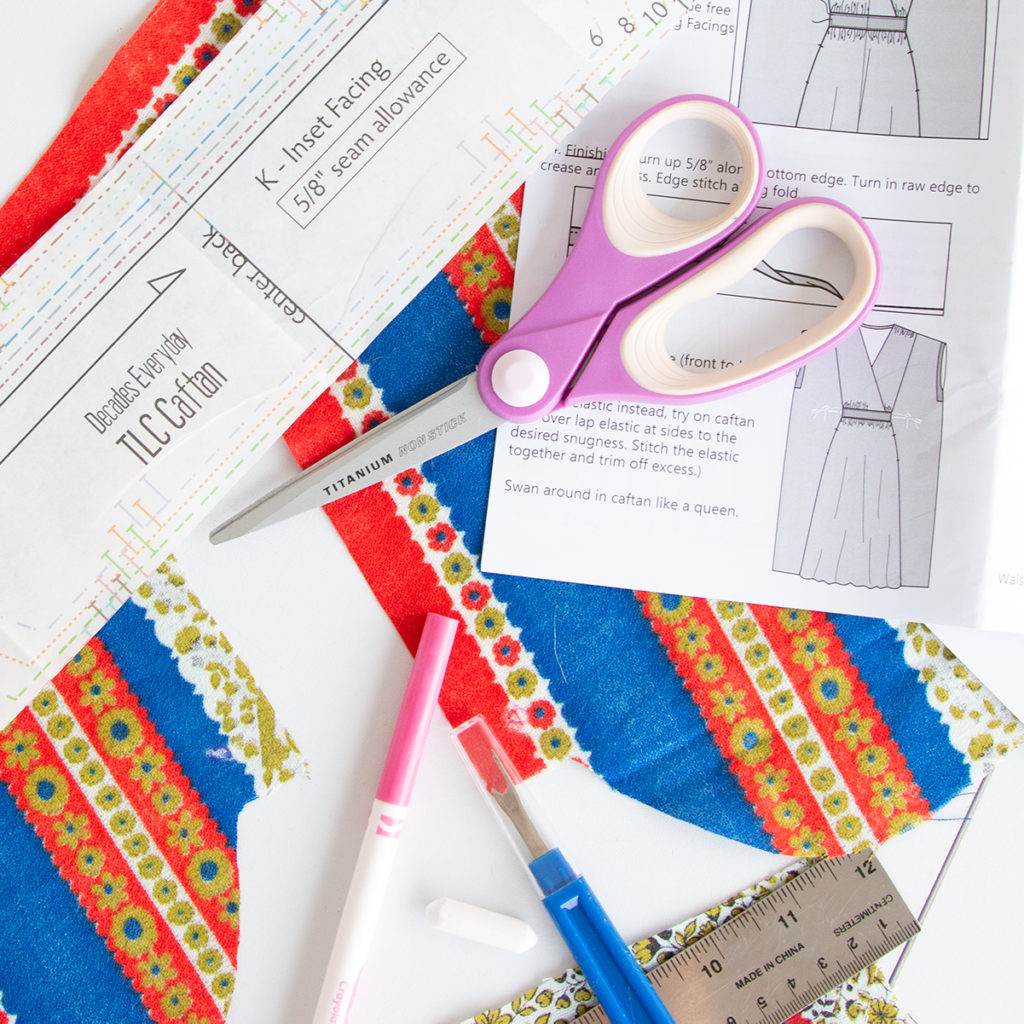
On Making the TLC Caftan
As a sewist in the midst of growing her skillset, I am delighted to report that this pattern was relatively easy. Making the TLC Caftan pattern was really a matter of a few gathers, lots of straight lines, and just a few challenging moments.
Easy moments
Choosing the pattern itself was a breeze. It was a pattern I’d seen on Instagram & mentally filed away as one to make if ever I had the right opportunity. While I assumed it would be far less fun than a friend’s bachelorette party (my first in years!), I’m so delighted this garment will forever be associated with her. And since it’s a caftan, I’ll always be able to wear it on hot days and as a swimsuit cover-up. Gotta love a handmade item with a little versatility!
Overall, this was a pretty easy sew. As a sewist, I definitely owe Decades of Style pattern company a debt of gratitude for creating patterns that are straightforward and fun to make (note: this is not a sponsored post). I’ve made a couple of Decades patterns in recent years to rekindle my skills at working from a printed pattern, and they definitely did the job! The designs are interesting, they’re on trend without being basic, and if you’ve got an affinity for vintage or vintage-inspired clothing, they’re a great place to find some cool designs.
Ok, about this caftan specifically. The available sizes for the TLC Caftan range from a U.S. 6 to 26., and it comes printed on nice quality paper. This pattern even came printed in color so cutting out/tracing your size is easier than following dotted/dashed lines all in black. (Some of Decades’ older patterns weren’t done in color, but I’m excited they made the change because it makes cutting/tracing your pattern pieces so simple.)
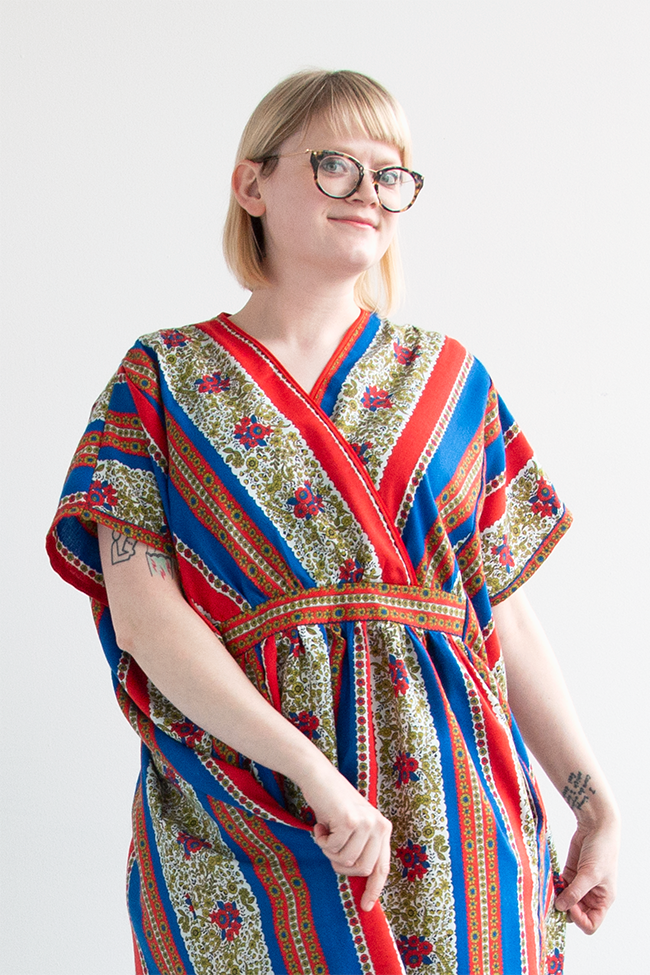
Challenging moments
Fabric selection, twill tape & pattern matching
My TLC Caftan was made with vintage fabric I’d found at a garage sale. It was the only fabric there, and it was about 4.5 yards of 44″ wide 1960s semi-psychedelic goodness. Between not being much of a sewist before the last year or so and feeling like this booooold print needed to be worked with wisely, it had been in my stash for 7 years or so. I think I managed to save it for just the right project!
The TLC Caftan can be made as written with a shorter or longer length. Even with the long yardage of my vintage fabric, I had to make the shorter length (which might be more versatile for day to day wear in the end, so it’s cool). I clock in at a size 12 for this pattern, so I would have needed 5.5 yards of 44″ wide fabric for the longer version. It worked out, once again, because in addition to the 3 3/8 yards of fabric for the caftan body, this pattern calls for 3/8 of a yard of contrast fabric. I simply used some of my excess fabric and was able to play liberally with pattern matching and selecting where to cut the “contrast fabric” from. This was my first actual attempt at sort of pattern matching, so finding just the right section to stand out against my caftan body while still matching was terribly exciting!
I think the hardest thing to track down was twill tape. No one at my local JoAnn store knew what it was (
Construction
If you’ve ever made a fit and flare dress, this caftan is seriously no big deal to sew. Most of it was pattern matching during the cutting process, straight lines, and some small gathers. The real challenges I faced in making this garment were minor and mostly due to my still-developing sewing skillset.
The three biggest challenges for me were: sewing bias tape along the neckline to finish the edge, working blind from the outside to sew waist facing and twill tape on the inside of my garment, and sewing the armhole facing. Two of the challenges were related to sewing blind, so clearly I’ve found a specific skill to practice for next time! (A baby step, but still progress!)
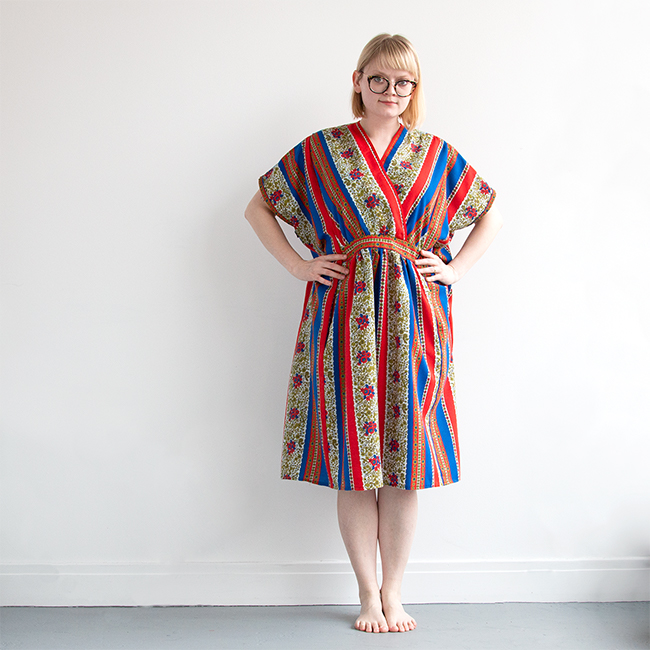
Lessons learned
If you’re working from amazing but ultimately mystery vintage fabric, it’s a good idea to test your iron settings on some scraps first. I didn’t end up scorching any of my fabric, but I definitely had a close call!
When I talked about making this caftan on the Very Serious Crafts Podcast (listen to the episode here), my co-host Haley mentioned something that didn’t even occur to me until after I’d finished sewing. I was excited that I wouldn’t have to do too many adjustments to make this caftan fit. (Often I have to take in the shoulders/back of a lot of what I make to fit my petite zones, which is the whole point of learning to be a better sewist.) Haley is experienced at making petite clothes with adjustments for her shape and recommended working from a size down on a pattern with lots of positive ease (extra room). That would have been a super simple decision to make up front, and I’m absolutely going to remember that the next time I cut out a flowy pattern.
Oh, and I learned a useful sewing vocabulary phrase while making this pattern: stay stitching. And it’s already come in handy! I’ll wrap up this first handmade wardrobe post with a few blog posts on the subject in case you’re in the same newbieish sewing boat as me.
- Why Staystitching is Sooooo Important -Bluprint
- Sew Better with Staystitching Fundamentals -Threads
- 4 Tips for Staystitching -Colette blog


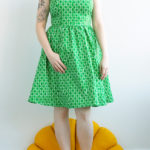




 & shop new patterns
& shop new patterns 





Leave a Reply